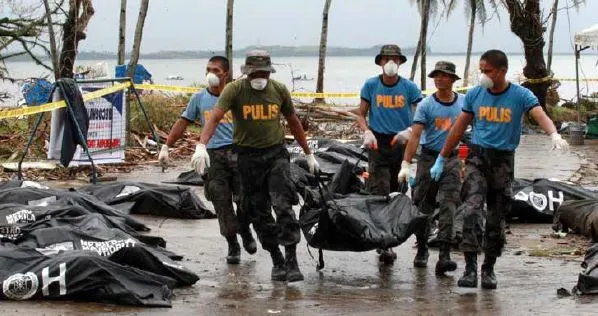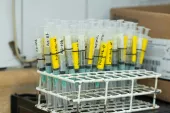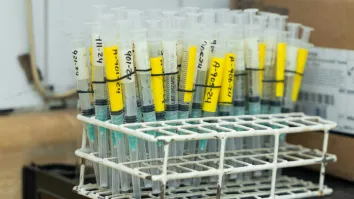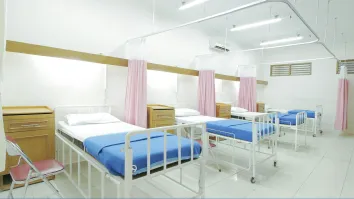
Responding to extreme disasters: a Haiyan case study
What can Asian countries learn from the strongest storm in 2013?
Even before typhoon Haiyan destroyed Eastern Visayas in the Philippines in Novemberlast year, officials from the Department of Health (DOH) were already in their bunker in Manila planning for and coordinating post-cyclone healthcare operations. But their scenarios could not prepare them for the scale of damage wrought by the strongest storm to hit the planet in 2013. In an exclusive interview with Healthcare Asia, DOH Assistant Secretary Enrique Tayag says the state agency had a five-day headstart to prepare for the super typhoon.
“Immediately, our response was to raise the white alert status in all hospitals in the affected areas. White alert means that hospitals will check their supplies, medicine, should have an inventory of their staff,” he says. In case the alert level is raised, the staff are asked to immediately report to work.
But the gravity of the disaster was so immense, some hospital staff were not able to report to work as they had to prioritize their own families. Hospitals and health centres were wiped out, and the government was faced with a looming health crisis. The scale of Haiyan’s impact on the Philippines - specifically on the
health sector- and the government’s level of response to an emergency of such scale, bring to the fore the capacity of developing countries to respond to such calamities, tagged by the Philippine Interior Secretary Manuel Roxas II as the ‘new normal.’
Economic effects
Typhoon Haiyan, or Yolanda, as it is called by the weather bureau in the Philippines, barrelled through the Visayas region on 8 November 2013, leaving an unprecedented trail of destruction in its path. More than 6,000 people were killed, mostly from storm surges, which caused seas to engulf nearby communities.
What local news agencies referred to as the ‘monster typhoon’ caused P24.5 billion ($544 million) in damages to the Philippines, according to figures released last November by the country’s National Economic and Development Authority. Socioeconomic and Planning Secretary Arsenio Balisacan said the devastation caused is expected to negatively affect the country’s fourth quarter gross domestic product (GDP) by as much 0.3 to 0.8 percent.
Matt Hildebradt of JP Morgan and Chase places the rebuilding cost around $6-7 billion, or around 2.3 percent of GDP. This figure is much lower than the initial estimate of $15 billion. The Eastern Visayas region accounts for 2.2 percent of the country’s GDP, and the typhoon affected its coconut and rice production, which accounts for 11 percent and 6 percent of national production, respectively.
JP Morgan raised its inflation forecast to 3 percent from 2.7 percent in 2013 and 4.3 percent from 3.1 percent in 2014. The bank downgraded its 2013 GDP forecast to 6.9 percent from 7.1 percent but raised its 2014 forecast to 6 percent from 5.6 percent due to the boost from rebuilding activities.
“President (Benigno Aquino III) stated in a televised address that the country has P18.7 billion ($414.5 million) in funds to help rebuild areas damaged by the typhoon,” JP Morgan says. Economist Michael Wan of Credit Suisse notes that the typhoon’s impact on the country’s headline GDP will likely be small and manageable, and agrees that economic expansion this year will likely be boosted by reconstruction. Remittances are also likely to be boosted in the near-term, which would support the country’s current account, Wan says.
Early response
Tayag says in case of national calamities, the Philippine government provides for a law that mandates concerned state agencies to coordinate with each other in responding to the needs of the citizens. The National Disaster Risk Reduction and Management Council (NDRRMC) is primarily responsible for overseeing nationwide operations during disasters.
The Department of Science and Technology is concerned with mitigation, while the Department of Interior and Local Government is tasked with ensuring the preparedness of local government units. In responding to the needs of victims, at the helm of operations is the Department of Social Welfare and Development. The rehabilitation phase is assigned to the National Economic and Development Authority.
Officials and staff from the DOH arrived in Tacloban, one of the hardest-hit cities in Eastern Visayas on the morning of 10 November, two days after Haiyan battered the area. The storm destroyed the Tacloban International Airport, prompting its closure, so officials like Tayag had to take helicopters to arrive at the location.
“It was a short visit because we had to go back before the night fell. The purpose of the mission was to make a very quick assessment. Just a quick assessment, then get instructions from the president,” Tayag says.
The next day, President Aquino declared a state of national calamity, empowering the national government to take over local government units in implementing and executing rescue, recovery, relief and rehabilitation work in areas affected by Haiyan.
Tayag clarifies, however, that even if the national government took over in much of the operations post-Haiyan, it still coordinated with the local government, especially with the challenges posed by language differences and geography. In Tacloban City, a majority of residents speak Waray, one of the native languages of the Philippines. “Even if you go there, you don’t know how to go about the place. That’s why you have to really work with the local government,” Tayag says.
The government official says that upon their arrival in Tacloban on 10 November, they saw major structural damage to the government hospital, the Eastern Visayas Regional Medical Center. All the other private hospitals were down. Tayag says the hospital was still able to conduct about eight operations a day with the help of a working generator, but they were already running out of supplies. Only about a quarter of the hospital’s personnel had reported for work despite the white alert.
“Of course they prioritized their families because they didn’t know what had happened to them,” Tayag says. Others suffered from posttraumatic stress disorders, which needed debriefings from psychosocial health teams. There were a handful of surgeons and anaesthesiologists who reported to work and attended to the needs of those suffering from wounds and trauma. Tayag’s group also brought antitetanus vaccines, and provided some to other hospitals.
The DOH set up a temporary command post in the hospital where people could be attended to, but communications were a problem as the major telecommunication providers were down. Tayag’s group, however, brought satellite phones, which helped them relay information to other groups from on the ground. Help from other areas also started arriving. “We were lucky the 136-contingent from Bicol region arrived, sent by (Albay) Governor (Joey) Salceda,” Tayag says.
According to the DOH, P1.45 billion ($32 million) is needed by the regional hospital to provide for public health services and facilities for the typhoon survivors. The bulk of the amount is needed for the provision of safe water, while another considerable chunk is for the restoration of power and transportation. In the four regions affected by
Haiyan, 38 hospitals are in immediate need of repair and rehabilitation, which will cost about P1.17 billion ($30 million).
In the next few days, the government’s problems started to pile up when the San Juanico Bridge connecting the provinces of Samar and Leyte had a traffic snarl from the volume of people arriving in and fleeing from the provinces. Tayag says after assessing the communications, they assessed the transportation situation so they could determine how to send needed responders and supplies. Due to problems in transportation, the responders thought of arriving via C130 planes, but that immediately seemed improbable since they had to compete with relief goods and security personnel, he says.
“Finally, our secretary negotiated and inked a deal with Air21 and Philippine Airlines (PAL). So by that time, we were able to secure flights to Cebu via PAL,” Tayag says. The responders were initially stationed in Cebu, a nearby city southwest of Tacloban, where they waited until the Tacloban International Airport partially reopened. Lack of communication made the situation a virtual chaos. “There were instructions that were not followed... for a few days we struggled with communications because we were struggling with satellite phones,” he says.
Threats to public health
“So we were already anticipating public health threats that may arise. We focused more on needs,” Tayag says. He says the government conducted a risk/needs assessment and sent personnel to assess the needs within affected areas. Tayag adds that the government’s priority in evacuation centres was accessibility to potable water, and the
sanitation and hygiene situation in the area.
“We had to maintain the health services. So we had to deploy medical teams. We had to work with WHO (World Health Organization) because the medical missions started to arrive,” he says. As countries from all over the world started sending their medical teams, the DOH coordinated with the Department of Foreign Affairs and WHO to coordinate with the foreign medical teams. The medical teams were classified according to those which could attend to outpatient concerns and those who could conduct operations. Based on this, teams were deployed where they were needed, Tayag says.
As medical teams were deployed, the mounting death toll posed another problem. Tayag says that based on their assessment, even if relief was coming along with food and medicine, there were thousands of dead bodies, a lot of which were not yet retrieved. Among those retrieved, many were not yet identified, and those identified were not yet buried.
“If you are not able to attend to that, the people’s impression would be, where is the government?” Tayag says, adding that the unattended bodies gave people the impression that the government was unable to work well and manage the situation. Identifying the dead was a task for the National Bureau of Investigation, but the management of dead bodies was assigned to the DOH. “Only we can declare what the death count is. Secondly, we supply the cadaver bags. Thirdly, we are the ones constantly advising people that they won’t get sick from dead bodies,” he says.
Another concern the DOH focused on was disease surveillance, for fears of possible outbreaks. Wounded victims were attended to and those with severe cases were transferred to Manila hospitals. There were also cases of leptospirosis and measles, and although DOH brought vaccines, they had to airlift a solar-powered refrigerator
from Sulu, one of the southernmost provinces in the Philippines, in order to preserve them.
Cases of tuberculosis also posed a problem, since the patient’s records were wiped out and conditions made it difficult to monitor whether or not a patient is regularly taking his or her medicine. Dengue posed a threat which prompted fogging operations.
He says with the different concerns of typhoon survivors, they had to make an inventory of how much help was needed to assist in the deployment of responders to various locations. Among them were dedicated teams ensuring the quality of water, sanitation and hygiene in the area. “It should be adequate and safe. Even if the water is safe, if it’s inadequate, people will still get sick,” he says.
Mental health is also a concern for the DOH, with a number of people expected to develop mental illness from the traumatic experience. “Our concern is, months from now, there is a proportion of people who will have mental disorders. Actually, our estimate for severe mental health disorder is around 1 percent. Those mild to moderate, around 5-10 percent,” Tayag says. He adds that they are already readying their staff for that situation, and that psychosocial teams are present to conduct stress debriefing to the survivors.
Health sector
With respect to the health sector, Haiyan wreaked havoc on 1,235 health facilities in the Philippines, leaving only 678 functional. Other facilities were either partially damaged or completely wiped out. Out of the damaged health facilities, 991 were barangay health stations - small health centres located in villages.
The typhoon also damaged 153 rural health units, 68 local government hospitals, seven city and district health centre, six retained hospitals, six city health offices, three private hospitals, and one municipal health office. The government estimates the cost of damage to health facilities at P1.123 billion ($25 million), and more than 60 percent of the damage was inflicted on infrastructure.
Typhoon Haiyan exposed the Philippines’ vulnerabilities to natural disasters on massive scales, and it is still uncertain how fast the country will recover from the calamity. When the 2004 tsunami hit Aceh, Indonesia, and killing 170,000 people in the area alone, it took years before the community got back on its feet. In a report in 2010, the United Nations Development Programme said rebuilding has been remarkable in the area, exceeding expectations from what was imaginable when it hit six years earlier.
“We are at the early recovery phase, then, we will have early rehabilitation. We call that post-disaster needs assessment. That means we’re assessing the damage to infrastructure and the impact to health workers... That is going to be planned, that’s what the president will be asking for,” Tayag says.
Last December, President Benigno Aquino III appointed former senator Panfilo Lacson as the Presidential Assistant for Rehabilitation and Recovery to allow the government to focus on the task of rebuilding Visayas. It is also his job to coordinate with the NDRRMC and its member agencies and consult with the concerned local government units in the formulation of plans and programs for the rehabilitation, recovery and development of the affected areas. He is expected to exercise oversight on relevant state agencies in the rehabilitation and recovery effort and call upon state bureaus for assistance in carrying out his mandate.
Balisacan said it would probably take three to four years for the affected areas to recover. Building permanent settlements for the displaced typhoon survivors would require more time since local government units in the areas affected have yet to update their land use plan and geohazard maps. He says currently, the government’s priority are those who could no longer move back to the hazard zones.
The DOH, for its part, is working on a report to be submitted to President Aquino, recommending further steps beyond the early recovery phase. “What helped us here were our skills and experience from past disasters. I was a veteran of the Ormoc flash flood in the nineties. Secondly, we get a lot of help, sometimes, even unsolicited. From international organizations to domestic, everyone helped,” Tayag says. Latest data from the Philippine government show that P23 billion ($539 million) has already been pledged by the international community as aid for the Haiyan survivors.
The government has so far received P593 million ($12.34 million) in cash out of the total amount pledged. But despite the outpouring of support and experience from previous calamities, Tayag concedes that the government was only able to do so much given Haiyan’s impact in Visayas. “You can only spring back so much. We’re not washing our hands but at least we were able to respond. It may not have been timely, it may not have been adequate, but there was real effort to help. There was real effort to cushion the health impact,” Tayag says.



















 Advertise
Advertise






